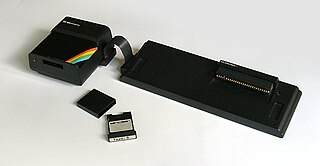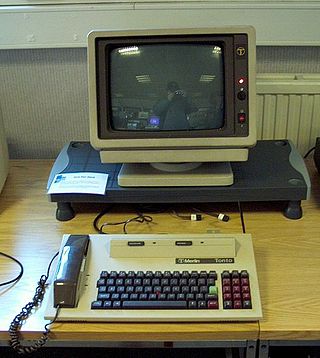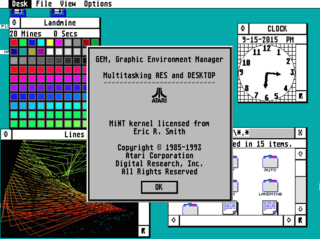Related Research Articles

The Amstrad CPC is a series of 8-bit home computers produced by Amstrad between 1984 and 1990. It was designed to compete in the mid-1980s home computer market dominated by the Commodore 64 and the ZX Spectrum, where it successfully established itself primarily in the United Kingdom, France, Spain, and the German-speaking parts of Europe.
The Sinclair QL is a personal computer launched by Sinclair Research in 1984, as an upper-end counterpart to the ZX Spectrum.

The ZX Spectrum is an 8-bit home computer developed and marketed by Sinclair Research. It was first released in the United Kingdom on 23 April 1982, and around the world in the following years, most notably in Europe, the United States, and Eastern Bloc countries.
Apple DOS is the family of disk operating systems for the Apple II series of microcomputers from late 1978 through early 1983. It was superseded by ProDOS in 1983. Apple DOS has three major releases: DOS 3.1, DOS 3.2, and DOS 3.3; each one of these three releases was followed by a second, minor "bug-fix" release, but only in the case of Apple DOS 3.2 did that minor release receive its own version number, Apple DOS 3.2.1. The best-known and most-used version is Apple DOS 3.3 in the 1980 and 1983 releases. Prior to the release of Apple DOS 3.1, Apple users had to rely on audio cassette tapes for data storage and retrieval.
Sinclair BASIC is a dialect of the programming language BASIC used in the 8-bit home computers from Sinclair Research, Timex Sinclair and Amstrad. The Sinclair BASIC interpreter was written by Nine Tiles Networks Ltd.

A peripheral from Sinclair Research for its ZX Spectrum home computer, the ZX Interface 1 was launched in 1983. Originally intended as a local area network interface for use in school classrooms, it was revised before launch to also act as the controller for up to eight ZX Microdrive high-speed tape-loop cartridge drives. It also included a DE-9 RS-232 interface capable of operating at up to 19.2 kbit/s. At hardware level it was fundamentally a voltage adaptor, the serial protocol being implemented in software by bit-banging. This led to problems when receiving data, but not when transmitting.

The Enterprise is a Zilog Z80-based home computer announced in 1983, but due to a series of delays, was not commercially available until 1985. It was developed by British company Intelligent Software and marketed by Enterprise Computers.
SMSQ/E is a computer operating system originally developed in France by Tony Tebby, the designer of the original QDOS operating system for the Sinclair QL personal computer. It began life as SMSQ, a QDOS-compatible version of SMS2 intended for the Miracle Systems QXL emulator card for PCs. This was later developed into an extended version, SMSQ/E, for the Atari ST. It consists of a QDOS compatible SMS kernel, a rewritten SuperBASIC interpreter called SBasic, a complete set of SuperBASIC procedures and functions and a set of extended device drivers originally written for the QL emulator for the Atari ST.
SuperBASIC is an advanced variant of the BASIC programming language with many structured programming additions. It was developed at Sinclair Research by Jan Jones during the early 1980s.
Sinclair Research Ltd was a British consumer electronics company founded by Clive Sinclair in Cambridge. It was originally incorporated in 1973 as Westminster Mail Order Ltd, renamed Sinclair Instrument Ltd, then Science of Cambridge Ltd, then Sinclair Computers Ltd, and finally Sinclair Research Ltd. It remained dormant until 1976, when it was activated with the intention of continuing Sinclair's commercial work from his earlier company Sinclair Radionics, and adopted the name Sinclair Research in 1981.
Minerva is a reimplementation of Sinclair QDOS, the built-in operating system of the Sinclair QL line of personal computers. Written by Laurence Reeves in England, Minerva incorporates many bug fixes and enhancements to both QDOS and the SuperBASIC programming language. Later versions also provide the ability to multi-task several instances of the SuperBASIC interpreter, something not supported by QDOS.

Beta BASIC is a BASIC interpreter for the Sinclair Research ZX Spectrum microcomputer, written by Dr Andrew Wright in 1983 and sold by his one-man software house BetaSoft. BetaSoft also produced a regular newsletter/magazine, BetaNews.

The One Per Desk, or OPD, was an innovative hybrid personal computer/telecommunications terminal based on the hardware of the Sinclair QL. The One Per Desk was built by International Computers Limited (ICL) and launched in the United Kingdom in 1984. It was the result of a collaborative project between ICL, Sinclair Research and British Telecom begun in 1983, originally intended to incorporate Sinclair's flat-screen CRT technology.
Tony Tebby is a computer programmer and the designer of Qdos, the computer operating system used in the Sinclair QL personal computer, while working as an engineer at Sinclair Research in the early 1980s.
The CST Thor series of personal computers are Sinclair QL-compatible systems designed and produced by Cambridge Systems Technology during the late 1980s.
The Q40 and Q60 are computer motherboards designed in the late 1990s, based on the Motorola 68040 and 68060 microprocessors respectively and intended to be partially compatible with the Sinclair QL microcomputer. Later these were sold as a fully assembled computer in an AT desktop case.

TOS is the operating system of the Atari ST range of computers. This range includes the 520ST and 1040ST, their STF/M/FM and STE variants and the Mega ST/STE. Later, 32-bit machines were developed using a new version of TOS, called MultiTOS, which allowed multitasking. More recently, users have further developed TOS into FreeMiNT.

Kickstart is the bootstrap firmware of the Amiga computers developed by Commodore International. Its purpose is to initialize the Amiga hardware and core components of AmigaOS and then attempt to boot from a bootable volume, such as a floppy disk. Most Amiga models were shipped with the Kickstart firmware stored on ROM chips.

The Radio-86RK is a build-it-yourself home computer designed in the Soviet Union. It was featured in the popular Radio magazine for radio hams and electronics hobbyists in 1986. The letters RK in the title stands for the words Radio ham's Computer. Design of the computer was published in a series of articles describing its logical structure, electrical circuitry, drawings of printed circuit boards and firmware. The computer could be built entirely out of standard off-the-shelf parts. Later it was also available in a kit form as well as fully assembled form.

The Gigatron TTL is a retro-style 8-bit computer, where the CPU is implemented by a set of TTL chips instead of a single microprocessor, imitating the hardware present in early arcades. Its target is the computing enthusiasts, for studying or hobby purposes.
References
- Andrew Pennell (1985). The Sinclair QDOS Companion: a guide to the QL operating system. London: Sunshine Books. ISBN 0-946408-69-6
- Simon Goodwin. "Bugging the ROM", Sinclair QL World, August 1987
- QL History FAQ: Firmware